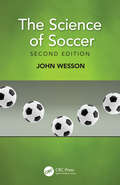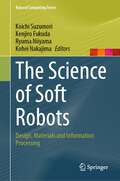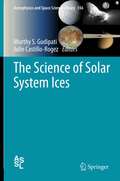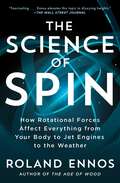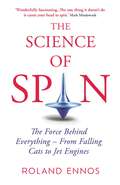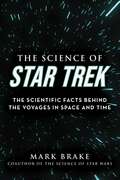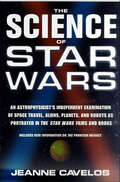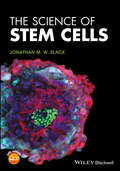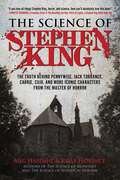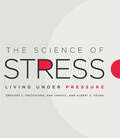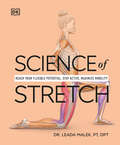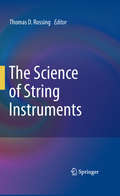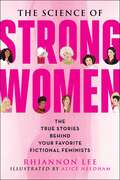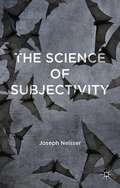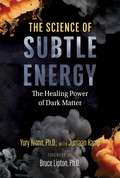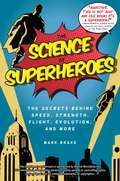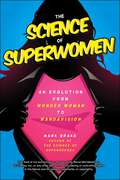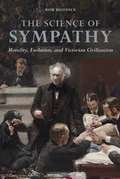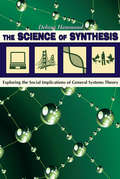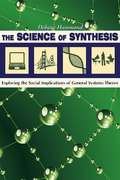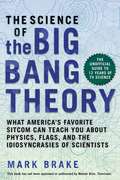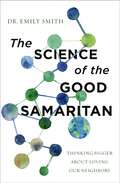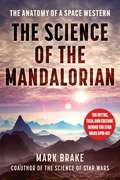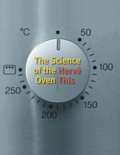- Table View
- List View
The Science of Soccer
by John WessonUpdated and revised throughout, this new edition of The Science of Soccer applies scientific analysis to football, giving us the answers to questions like "what's the chance of a team that wins the Premiership also winning the Cup? Can you predict how many goals will be scored? What's the best height for footballers? Is the team that wins the league the best team?" Starting with a qualitative description of the basic physics that relate to the ball and its bounce, the author then moves through kicks and throws, to a simple account of the more complex physics of a ball in flight. Fulfilling your scientific curiosity, this book uncovers aspects of the game that are not normally discussed. It includes a look at game theory, how the rules affect the flow and enjoyment of the game, unusual statistics about players, and an insight into the economics of the game. For those with a more mathematical interest in the physics, the final chapter provides a readable account of the theory behind the beautiful game. Features: Accessible to anyone interested in understanding more about the science behind the sport Updated throughout, with new content on transfer fees, wages, and the top goal-scorers Discusses topics not explored in current literature, including rudimentary game theory
The Science of Soft Robots: Design, Materials and Information Processing (Natural Computing Series)
by Koichi Suzumori Kenjiro Fukuda Ryuma Niiyama Kohei NakajimaThe goal of this textbook is to equip readers with as structured knowledge of soft robotics as possible. Seeking to overcome the limitations of conventional robots by making them more flexible, gentle and adaptable, soft robotics has become one of the most active fields over the last decade. Soft robotics is also highly interdisciplinary, bringing together robotics, computer science, material science, biology, etc. After the introduction, the content is divided into three parts: Design of Soft Robots; Soft Materials; and Autonomous Soft Robots. Part I addresses soft mechanisms, biological mechanisms, and soft manipulation & locomotion. In Part II, the basics of polymer, biological materials, flexible & stretchable sensors, and soft actuators are discussed from a materials science standpoint. In turn, Part III focuses on modeling & control of continuum bodies, material intelligence, and information processing using soft body dynamics. In addition, the latest research results and cutting-edge research are highlighted throughout the book. Written by a team of researchers from highly diverse fields, the work offers a valuable textbook or technical guide for all students, engineers and researchers who are interested in soft robotics.
The Science of Solar System Ices
by Julie Castillo-Rogez Murthy S. GudipatiThe role of laboratory research and simulations in advancing our understanding of solar system ices (including satellites, KBOs, comets, and giant planets) is becoming increasingly important. Understanding ice surface radiation processing, particle and radiation penetration depths, surface and subsurface chemistry, morphology, phases, density, conductivity, etc., are only a few examples of the inventory of issues that are being addressed by Earth-based laboratory research. As a response to the growing need for cross-disciplinary dialog and communication in the Planetary Ices science community, this book aims to achieve direct dialog and foster focused collaborations among the observational, modeling, and laboratory research communities.
The Science of Spin: How Rotational Forces Affect Everything from Your Body to Jet Engines to the Weather
by Roland EnnosA clear and captivating work of popular science that explains rotational force—a basic driver of the universe affecting everything from the cosmos to our own bodies—from the masterful author of The Age of Wood.From the time women first used rotating bobbins to twist thread and men whirled slings around their heads to throw stones, people have found spin fascinating and baffling in equal measure. Now, in The Science of Spin, Roland Ennos shows how rotational motion dominates the workings of the world around us. It has shaped the solar system, galaxies, and black holes. It controls our climate and weather—from the pattern of trade winds through to the local formation of hurricanes and tornadoes. Harnessing the power of spin helped launch civilization, from the first developments of the wheel to the systems that now power the industrial world—propellers, turbines, centrifugal pumps, and electric motors. Even our own bodies are complex systems of rotating joints and levers. But scientists have a tendency to ignore the simple and straightforward. So, 17th-century scientists developed the science of mechanics to explain the phenomenon of the orbit of the planets rather than how machines work. And Newton&’s laws have actually limited our understanding of spin because they focus on linear motion rather than on an intuitive grasp of rotation. As a result, few people realize how spin makes our planet habitable, or how it has been tamed by engineers to make our lives more comfortable. In a lively and engaging style, Ennos presents a new approach to mechanics that not only helps us better understand the world, but also reveals unlikely links between tightrope walkers and tyrannosaurs, catapults and tennis players, stunt cars and long jumpers. By opening our minds, he shows how we can all learn to move about more gracefully, play sports more successfully and safely—and ensure that, like cats, we always land on our feet. A highly entertaining and informative read, whether it be natural or engineered, spin is what really makes the world go round.
The Science of Spin: The Force Behind Everything – From Falling Cats to Jet Engines
by Roland EnnosWhy exactly is the Earth round? How is it that boomerangs can turn in mid-air? And why do cats always land on their feet? From the solar system to spinning tops; hurricanes to hula hoops; powerplants to pendulums, one mysterious force shapes almost every aspect of our lives. A force which, despite its ubiquity, continues to confound, baffle and surprise. Artfully moving between astrophysics and anthropology, The Science of Spin provides a sweeping journey through space and time, from the creation of the Earth to the advent of the &‘fidget spinner&’. Charting the development of engineering and technology from the earliest prehistoric drills to the turbine engine, critically acclaimed author and scientist Roland Ennos presents a riveting account of human ingenuity and the seemingly infinite ways spin affects our daily lives.
The Science of Star Trek: The Scientific Facts Behind the Voyages in Space and Time (The Science of)
by Mark BrakeBoldly go where no man has gone before and discover the real science behind the cyborgs, starships, aliens, and antimatter of the Star Trek galaxy.Star Trek is one of the highest-grossing media franchises of all time. It has changed our cultural landscape in so many ways since it first aired in 1966. The franchise has generated billions of dollars in revenue, leading to a wide range of spin-off games, novels, toys, and comics. Star Trek is noted for its social science, too, with its progressive civil rights stances and its celebration of future diversity that began with The Original Series, one of television's first multiracial casts. The Science of Star Trek explores one of the greatest science-fiction universes ever created and showcases the visionary tech that inspired and influenced the real-world science of today. The perfect Star Trek gift for fans of the franchise, this book addresses many unanswered, burning questions, including: What can Star Trek tell us about aliens in our Milky Way?How has Star Trek influenced space culture?What can Star Trek tell us about planet hunting?What Star Trek machines came true?When will we boldly go? Learn more about one of our favorite modern epics with The Science of Star Trek!
The Science of Star Wars: An Astrophysicist's Independent Examination of Space Travel, Aliens, Planets, and Robots as Portrayed in the Star Wars Films and Books
by Jeanne CavelosCould the science fiction of Star Wars be the actual science of tomorrow?-How close are we to creating robots that look and act like R2-D2 and C-3PO?-Can we access a "force" with our minds to move objects and communicate telepathically with each other?-How might spaceships like the Millennium Falcon make the exhilarating jump into hyperspace?-What kind of environment could spawn a Wookiee?-Could a single blast from the Death Star destroy an entire planet?-Could light sabers possibly be built, and if so, how would they work?-Do Star Wars aliens look like "real" aliens might?-What would living on a desert planet like Tatooine be like?-Why does Darth Vader require an artificial respirator?Discover the answers to these and many other fascinating questions of physics, astronomy, biology and more, as a noted scientist and Star Wars enthusiast explores The Science of Star Wars.
The Science of Stem Cells
by Jonathan M. SlackIntroduces all of the essential cell biology and developmental biology background for the study of stem cells This book gives you all the important information you need to become a stem cell scientist. It covers the characterization of cells, genetic techniques for modifying cells and organisms, tissue culture technology, transplantation immunology, properties of pluripotent and tissue specific stem cells and, in particular, the relevant aspects of mammalian developmental biology. It dispels many misconceptions about stem cells—especially that they can be miracle cells that can cure all ills. The book puts emphasis on stem cell behavior in its biological context and on how to study it. Throughout, the approach is simple, direct, and logical, and evidence is given to support conclusions. Stem cell biology has huge potential for advancing therapies for many distressing and recalcitrant diseases, and its potential will be realized most quickly when as many people as possible have a good grounding in the science of stem cells. Content focused on the basic science underpinning stem cell biology Covers techniques of studying cell properties and cell lineage in vivo and in vitro Explains the basics of embryonic development and cell differentiation, as well as the essential cell biology processes of signaling, gene expression, and cell division Includes instructor resources such as further reading and figures for downloading Offers an online supplement summarizing current clinical applications of stem cells Written by a prominent leader in the field, The Science of Stem Cells is an ideal course book for advanced undergraduates or graduate students studying stem cell biology, regenerative medicine, tissue engineering, and other topics of science and biology.
The Science of Stephen King: The Truth Behind Pennywise, Jack Torrance, Carrie, Cujo, and More Iconic Characters from the Master of Horror (The Science of Series)
by Meg Hafdahl Kelly FlorenceUncover the theories behind the Master of Horror's macabre tales: It, The Shining, Carrie, Cujo, Misery, Pet Semetary, and so much more! Gothic media moguls Meg Hafdahl and Kelly Florence, authors of The Science of Monsters and The Science of Women in Horror, and co-hosts of the Horror Rewind podcast called &“the best horror film podcast out there&” by Film Daddy, present a guide to the Stephen King stories and characters we all know and love. Through interviews, literary and film analysis, and bone-chilling discoveries, The Science of Stephen King delves into the uniquely horrific Stephen King universe to uncover the science behind the legendary novels that have become an integral part of modern pop culture, answering such questions as: What is the science behind time travel and parallel universes like in The Dark Tower series and 11/22/63?How does lack of sleep affect the human body like in Insomnia?Is it possible for horrific creatures to exist like in Nightshift?What is the science behind curses and legends like in Dreamcatcher and Thinner? Join Kelly and Meg as they learn if we all really do float down here!
The Science of Stress: Living Under Pressure
by Gregory L. Fricchione, Ana Ivkovic, Albert Yeung&“A comprehensive examination of stress&” from three prominent neuropsychiatrists (The Boston Globe). Jobs and families. Deluges of digital communication. The constant demands on our time and money. The screaming match of politics and the threat of terrorism and war. There&’s no doubt we&’re stressed out—but what exactly is it doing to us? Neuropsychiatrists Gregory L. Fricchione, Ana Ivkovic, and Albert Yeung gently remind us in this book that persistent stress is directly linked to chronic ailments like heart disease, diabetes, and depression, contributing to one of the biggest health challenges facing the world in the twenty-first century. As they show, alleviating stress is a task no one physician can accomplish. It&’s not the sort of problem a surgeon can excise with a scalpel or an internist can eradicate with antibiotics. It requires everyone&’s efforts—the healthy, the sick, doctors, nurses, psychologists, clergy, community leaders, and beyond—to pull together to address the stress-induced drivers in our world that undermine our health. Clearly and accessibly exploring the latest in modern neuroscience and immunology, the authors examine what those drivers are and how they reduce the body&’s metabolic reserve, making us more vulnerable to illness. They then look at the antidote: enhanced resilience, something we can achieve by intelligently adjusting how we face the significant adversities that can spring up in so many facets of our lives. With innumerable insights on the personal and social causes of stress and its physiological effects, this book serves as an essential guide to properly taking care of ourselves.
Science of Stretch: Reach Your Flexible Potential, Stay Active, Maximize Mobility (DK Science of)
by Dr. Leada MalekExplore new movements and alleviate stiff joints with more than 100 exercises designed to keep you flexible, energized, and active for life. Pain and stiffness can create fear and uncertainty in our ability to move, affecting quality of life. Exercise has continuously proven to be beneficial against disease, yet people are becoming increasingly sedentary.More than a quarter of the world's population is insufficiently active and it's time we remove barriers to exercise and encourage movement exploration. The Science of Stretch is your guide to understanding the human body's resilient and adaptable nature and how stretching can play a role in achieving your highest well-being.Inside the pages of this book you'll learn about:-The latest research on stretching-Human anatomy and physiology-The nervous system and pain science-How to reduce injury risk with exercise-Managing a lifestyle catered towards healthy aging-What happens to the body when we stretch-Different types of stretching and how to implement them to best compliment your daily life or sporting activities-Finally, a series of suggested stretch routines are outlined, each with a progressive increase in challenge and tailored to different abilities and fitness objectives-alongside the tools to create your own bespoke workouts.Every exercise is anatomized in detail to make movement easily understood using CGI artworks to show how each muscle is correctly activated and each joint aligned. Whether you're taking a walk around the park or running a marathon, Science of Stretch will help you stay flexible, keep active, and remove the uncertainty from stretching.
The Science of String Instruments
by Thomas D. RossingThis book will be a non-technical book on string instruments that includes some technical information as well. The emphasis will be on the practical understanding of string instruments, with the interests of performers and instrument builders in the forefront. Authors of the chapters will be musicians, scientists, and instrument designers and builders with practical experience. The mathematics will be kept as simple as possible by translating ideas from the language of physics (mathematics) to non-mathematical language. Considerable emphasis will be placed on the design and construction of string instruments. Following the structure of the author's successful Science of Percussion Instruments (World Scientific, 2000), technical ideas will be presented as "interludes." Readers who wish to go beyond the simple ideas in this book can easily follow the references to more scientific books and to the original scientific literature.
The Science of Strong Women: The True Stories Behind Your Favorite Fictional Feminists (The Science of)
by Rhiannon LeeDiscover all there is to know about strong women in fiction: Hermione Granger, Wonder Woman, Princess Leia, and more!A strong woman is not just a badass lady who solves her problems with a high kick and a sassy comeback, all the while looking fabulous in a cape (although the cape is a plus!). A strong woman is a pioneer for bravery, intelligence, determination, and social justice for all.Compelling, humorous, and brilliantly illustrated in equal measures, The Science of Strong Women showcases a collection of fifty fantastic fictional feminists we all know and love. Through media analysis and awe-inspiring discoveries, this inspirational guide delves deeper into female-forward fiction and features a truly diverse collection of strong women including: June OsborneStar CarterKatniss EverdeenElizabeth BennetÉowynJo MarchBuffy SummersAnd many more Here&’s to strong women. May we know them, may we be them, and may we learn from them with The Science of Strong Women.
The Science of Subjectivity
by Joseph NeisserCan neuroscience help explain the first-person perspective? The Science of Subjectivity delves into the nature of experience, arguing that unconscious subjectivity is a reality. Neisser identifies the biological roots of the first-person, showing how ancient systems of animal navigation enable creatures like us to cope with our worldly concerns.
The Science of Subtle Energy: The Healing Power of Dark Matter
by Yury Kronn• Shares the results of the author&’s rigorous, repeatable, and predictable experiments with subtle energy • Shows how the mind interacts with matter by means of subtle energy--the key to the placebo effect, the healing power of affirmations and prayers, and energy medicine • Demonstrates how to harness subtle energy and explains the author&’s technology to generate subtle energy formulations with practical applications Instruments of modern physics can measure the energies of the electromagnetic spectrum, but these energies only account for roughly 4 percent of the total identifiable mass-energy of the universe. What makes up the remaining 96%? In this scientifically-based yet accessible analysis, Yury Kronn, Ph.D., explores the nature of the remaining 96% of the universe&’s mass-energies. Contemporary science calls this mass-energy &“dark matter,&” and the ancients called it life force, prana, or chi. Dr. Kronn shows how this subtle energy belongs to the subatomic world and how it follows laws that are fundamentally different from those known to contemporary science. Sharing the results of his rigorous, repeatable, and predictable experiments with subtle energy, the author looks at the possible mechanisms of subtle energy&’s interaction with physical matter and with the human body. He shows how the mind interacts with matter by means of subtle energy--giving us the key to understanding the placebo effect and extrasensory perception as well as the healing power of affirmations, and energy medicine. Dr. Kronn demonstrates how it&’s possible to harness subtle energy and explains his development of Vital Force Technology, which integrates ancient knowledge of the life force with modern technology to generate specific subtle energy formulations for practical applications. He presents his experimental results creating subtle energy formulas to positively influence the germination of seeds and the growth of plants. He also demonstrates the possibility of using subtle energy for creating clean and energetic-pollution-free environments for vitality and better healing. Outlining the many benefits of subtle energy technology to individuals, societies, and the planet as a whole, Dr. Kronn reveals how the transformative power of subtle energy arises from the vast potential of human consciousness.
The Science of Superheroes: The Secrets Behind Speed, Strength, Flight, Evolution, and More (The\science Of Ser.)
by Mark BrakeDiscover the science behind the abilities of your favorite superheroes! The concept of the superhero has permeated our culture. They fascinate their fans with their incredible superhuman abilities and impressive technology. But do you ever wonder if any of it is plausible or rooted in fact? Enter The Science of Superheroes, which address more than fifty topics that span the worlds of your favorite superheroes and villains. Explore and examine their amazing abilities and fantastic gadgets with a detailed scientific lens. The scientific questions examined within this book include: Can an Iron Man suit be made? How does Thor's hammer work? Could any known forms of radiation cause superpowers? How many calories does Superman need each day? Could you cross a Lamborghini and a hummer to make the Batmobile Tumbler? And many more! Whether you're a movie or comic buff, this book is certain to entertain and open your eyes to the truth behind these amazing characters.
The Science of Superwomen: An Evolution from Wonder Woman to WandaVision (The Science of)
by Mark BrakeCelebrate the rise of superwomen and discover the science behind the abilities of Wonder Woman, Scarlet Witch, Black Widow, Catwoman, and more! Superhero fiction has been with us for almost a century; high-octane tales crammed with concepts and contrasting themes, from superpowers and the post-human, to masked vigilantes and immortality. In that time, superwomen have evolved from comic book caricatures (created by men, for men) to stronger representations of female power. The Science of Superwomen looks at this evolution, from its hypersexualized origins to today&’s more nuanced diversity. Focusing on characters from Star Wars and X-Men, as well as the likes of Wonder Woman, Batgirl, Captain Marvel, Harley Quinn, Wednesday Addams, Doctor Who, and Buffy the Vampire Slayer, The Science of Superwomen explores the relationship between superhero film and fiction and the underlying science of our ever-evolving universe.
The Science of Sympathy: Morality, Evolution, and Victorian Civilization (History of Emotions)
by Rob BoddiceIn his Descent of Man , Charles Darwin placed sympathy at the crux of morality in a civilized human society. His idea buttressed the belief that white, upper-class, educated men deserved their sense of superiority by virtue of good breeding. It also implied that societal progress could be steered by envisioning a new blueprint for sympathy that redefined moral actions carried out in sympathy's name. Rob Boddice joins a daring intellectual history of sympathy to a portrait of how the first Darwinists defined and employed it. As Boddice shows, their interpretations of Darwin's ideas sparked a cacophonous discourse intent on displacing previous notions of sympathy. Scientific and medical progress demanded that "cruel" practices like vivisection and compulsory vaccination be seen as moral for their ultimate goal of alleviating suffering. Some even saw the so-called unfit--natural targets of sympathy--as a danger to society and encouraged procreation by the "fit" alone. Right or wrong, these early Darwinists formed a moral economy that acted on a new system of ethics, reconceptualized obligations, and executed new duties. Boddice persuasively argues that the bizarre, even dangerous formulations of sympathy they invented influence society and civilization in the present day.
The Science of Synthesis: Exploring the Social Implications of General Systems Theory
by Debora HammondDebora Hammond's The Science of Synthesis explores the development of general systems theory and the individuals who gathered together around that idea to form the Society for General Systems Research. In examining the life and work of the SGSR's five founding members-Ludwig von Bertalanffy, Kenneth Boulding, Ralph Gerard, James Grier Miller, and Anatol Rapoport-Hammond traces the emergence of systems ideas across a broad range of disciplines in the mid-twentieth century. Both metaphor and framework, the systems concept as articulated by its earliest proponents highlights relationship and interconnectedness among the biological, ecological, social, psychological, and technological dimensions of our increasingly complex lives. Seeking to transcend the reductionism and mechanism of classical science-which they saw as limited by its focus on the discrete, component parts of reality-the general systems community hoped to complement this analytic approach with a more holistic orientation. As one of many systems traditions, the general systems group was specifically interested in fostering collaboration and integration among different disciplinary perspectives, with an emphasis on nurturing more participatory and truly democratic forms of social organization. The Science of Synthesis documents a unique episode in the history of modern thought, one that remains relevant today. This book will be of interest to historians of science, system thinkers, scholars and practicioners in the social sciences, management, organization development and related fields, as well as the general reader interested in the history of ideas that have shaped critical developments in the second half of the twentieth century.
The Science of Synthesis
by Debora HammondDebora Hammond's The Science of Synthesis explores the development of general systems theory and the individuals who gathered together around that idea to form the Society for General Systems Research. In examining the life and work of the SGSR's five founding members-Ludwig von Bertalanffy, Kenneth Boulding, Ralph Gerard, James Grier Miller, and Anatol Rapoport-Hammond traces the emergence of systems ideas across a broad range of disciplines in the mid-twentieth century. Both metaphor and framework, the systems concept as articulated by its earliest proponents highlights relationship and interconnectedness among the biological, ecological, social, psychological, and technological dimensions of our increasingly complex lives. Seeking to transcend the reductionism and mechanism of classical science-which they saw as limited by its focus on the discrete, component parts of reality-the general systems community hoped to complement this analytic approach with a more holistic orientation. As one of many systems traditions, the general systems group was specifically interested in fostering collaboration and integration among different disciplinary perspectives, with an emphasis on nurturing more participatory and truly democratic forms of social organization. The Science of Synthesis documents a unique episode in the history of modern thought, one that remains relevant today. This book will be of interest to historians of science, system thinkers, scholars and practitioners in the social sciences, management, organization development and related fields, as well as the general reader interested in the history of ideas that have shaped critical developments in the second half of the twentieth century.
The Science of The Big Bang Theory: What America's Favorite Sitcom Can Teach You about Physics, Flags, and the Idiosyncrasies of Scientists (The Science of Series)
by Mark BrakeThe geeks will inherit the earth.With well over two hundred episodes and a dozen seasons, The Big Bang Theory is one of America’s favorite television series, bringing a new class of character to mainstream television: the science nerd.In spite of its evident popularity and influence in shaping public attitudes to science and scientists, there are relatively few books that explore the show’s culture and social dimension. The Science of The Big Bang Theory looks behind the comedy scenes and scripts of this long-running and successful TV show to explore topics such as:The Bachelor Party Corrosion and ArchimedesThe Valentino Submergence: Fun with FlagsThe Dumpling Decoupling: Sheldon and Doctor WhoThe Mystery Date Observation: The Unlikely Dating Habits of EggheadsAnd More!This book is a light-hearted science companion to TV's The Big Bang Theory, providing you with just the kind of dissection of the science and culture you’d need to understand “math, science, history, unraveling the mysteries, that all started with the big bang! Hey!”
The Science of the Good Samaritan: Thinking Bigger about Loving Our Neighbors
by Dr. Emily SmithWhat does it mean to love your neighbor in today's fraught, divided world?Join Dr. Emily Smith, global health expert and creator of the popular Facebook page Friendly Neighbor Epidemiologist, as she dives into what loving your neighbor--as illustrated in the biblical parable of the Good Samaritan--truly means. Combining Dr. Smith's expertise as a scientist with her deep Christian faith while drawing from her journey from small-town Texas to a prestigious university, The Science of the Good Samaritan shares fascinating stories from Dr. Smith's life and the lives of other inspiring people around the world to show us how to:Find shared values with people from different backgrounds, faiths, and cultures than our ownReach outside our immediate circles to bring in those on the marginsRedefine our concept of "neighbor" and love our neighbors in more practical and global waysBridge the gaps of society's disparities and inequitiesYou can help reimagine and create a better world--and it all starts with authentically loving your neighbor.
The Science of The Mandalorian: The Anatomy of a Space Western (The Science of)
by Mark BrakeTake a trip beyond this Earth to explore the myths of The Mandalorian and uncover the anatomy of the newest space western in the Star Wars Universe.Star Wars dominates the film world. The combined box office revenue of the Star Wars movies equates to over $10 billion, making it the second highest-grossing film franchise of all time. But this franchise is no blaster from the past. Its fantastically successful films have now been followed by multiple television series set in that same galaxy far, far away. The franchise&’s flagship television series, and likely the firmest fan favorite for some time to come, is The Mandalorian. Tracing the tale of the titular bounty hunter, traveling across the furthest reaches of that mythic galaxy, The Mandalorian has been greatly praised and highly acclaimed for creating characters with gravitas and originality, worlds with depth and impact, resulting in some of the best Star Wars content ever. Even though it&’s set in deep space, The Mandalorian has as much in common with Western movies as it does with science fiction. Saloons. Bandits. &“Gun&” duels. Bounty hunters. Outlaws with a price on their heads. Space exploration as a &“final frontier.&” And a wild hero who doesn&’t quite belong in a lawless part of the Galaxy after the fall of the Empire.The Science of The Mandalorian takes you on a badass journey with a mysterious, lone gunfighter in the outer reaches of the galaxy, where your beskar armor will protect you from many things, but not the sight of a small, green, carnivorous humanoid with big black eyes and mysterious powers. This is the way.
The Science of the Oven
by Herv This Jody GladdingMayonnaise "takes" when a series of liquids form a semisolid consistency. Eggs, a liquid, become solid as they are heated, whereas, under the same conditions, solids melt. When meat is roasted, its surface browns and it acquires taste and texture. What accounts for these extraordinary transformations? The answer: chemistry and physics. With his trademark eloquence and wit, Hervé This launches a wry investigation into the chemical art of cooking. Unraveling the science behind common culinary technique and practice, Hervé This breaks food down to its molecular components and matches them to cooking's chemical reactions. He translates the complex processes of the oven into everyday knowledge for professional chefs and casual cooks, and he demystifies the meaning of taste and the making of flavor. He describes the properties of liquids, salts, sugars, oils, and fats and defines the principles of culinary practice, which endow food with sensual as well as nutritional value. For fans of Hervé This's popular volumes and for those new to his celebrated approach, The Science of the Oven expertly expands the possibilities of the kitchen, fusing the physiology of taste with the molecular structure of bodies and food.
The Science of the Oven (Arts and Traditions of the Table: Perspectives on Culinary History)
by Hervé ThisMayonnaise "takes" when a series of liquids form a semisolid consistency. Eggs, a liquid, become solid as they are heated, whereas, under the same conditions, solids melt. When meat is roasted, its surface browns and it acquires taste and texture. What accounts for these extraordinary transformations?The answer: chemistry and physics. With his trademark eloquence and wit, Hervé This launches a wry investigation into the chemical art of cooking. Unraveling the science behind common culinary technique and practice, Hervé This breaks food down to its molecular components and matches them to cooking's chemical reactions. He translates the complex processes of the oven into everyday knowledge for professional chefs and casual cooks, and he demystifies the meaning of taste and the making of flavor. He describes the properties of liquids, salts, sugars, oils, and fats and defines the principles of culinary practice, which endow food with sensual as well as nutritional value.For fans of Hervé This's popular volumes and for those new to his celebrated approach, The Science of the Oven expertly expands the possibilities of the kitchen, fusing the physiology of taste with the molecular structure of bodies and food.
